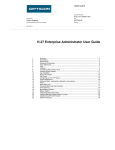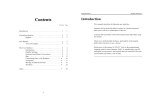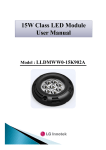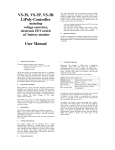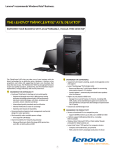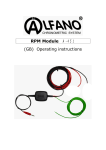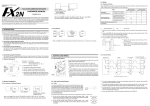Download AADIP_Chapter 6 - Intel® Developer Zone
Transcript
CHAPTER 6 Customization and Installation of Android Due to the characteristics of any em bedded sy stem s, such as resource constraints, tailoring and custom ization are im portant features for an em bedded OS, and Android is no exception. This chapter provides a general discussion of custom ization in an em bedded OS and then explains the custom ization of Android, specifically . Tailoring and Customization of an Embedded OS Not all functions and services provided by the em bedded OS are included in a special em bedded application, for two reasons. First, the em bedded system is always resource constrained, especially with regard to storage space; thus it is im possible to include all redundant functions in the sy stem at release. Second, m any commercial embedded OSs collect a licensing fee based on the com ponents chosen by the user. So, users should tailor the em bedded OS according to their individual needs. The principle of OS custom ization is shown in Figure 6-1. CHAPTER 6 Customization and Installation of Android Figure 6-1. Principle of OS customization For exam ple, Windows XP Embedded OS offers tens of thousands of components—more than the functions of desktop Windows XP . But for a subway baffle-gate system based on Windows XP Em bedded, for exam ple, com ponents such as Windows Media P lay er, the Internet Explorer browser, the DirectX settings panel, and Explor er task m anager are not required. Elim inating such com ponents reduces the hardware resources required by the sy stem, thus reducing the cost; and this m akes the sy stem operate faster, thereby im proving efficiency . A m ajority of embedded OSs provide m eans for custom ization and tailoring. However, there are m any different tailoring m odes: some start with com piling source code, which requires the user to configure the option of conditional com pilation; som e start by linking the target files, linking to different library files according to the user’s configuration; and the rem aining m odes extract precompiled files from the existing binary file library according to the user’s choice. Table 6-1 lists the custom ization m odes provided by frequently used em bedded OSs. Table 6-1. Customization Modes of Different Embedded Operating Systems Em b edded OS Cu sto m ization Mo des Windows CE Em bedded Linux P rovide P latform Builder IDE and graphical component options. Link different library files according to the selected components. For the kernel, generate config files via make config before; then com pile according to the configuration files. Windows XP Em bedded P rovide Target Designer IDE and graphical component options. Extract required binary files according to the selected components; no com pilation is necessary for the linking process. μC/OS-II Selectively and conditionally compile some part of the code according to the value defined by the C language m acro in the header file . VxWorks 2 Select which m odules are necessary in the Tornado IDE. CHAPTER 6 Customization and Installation of Android After system customization, y ou get an em bedded OS that runs on the target hardware device and has been optim ized for the special application field. Overview of Android Customization Theoretically , Android custom ization falls into two levels: custom ization of the Linux kernel and custom ization of the entire im age. Customization of the Linux kernel is sim ilar to custom ization of em bedded Linux: both involve the sam e methods and steps. Android customization m ainly focuses on im age custom ization. Let’s see why . ROM Package/Image The Android im age is com m only known as a read-only m em ory (ROM) package, which is the sy stem package of an Android phone. The reason for this nam ing convention is that m obile phones prior to Android phones, including sm artphones ( such as Nokia and WM) and non-sm art phones (such as Sony Ericsson, Moto P 2K platform , and MTK), all have a separate ROM chip storage sy stem file. So, the sy stem file is referred to as ROM package or ROM im age. The im age is a cross-compiled binary Linux file that can be installed and run on som e em bedded device, becoming the OS of the device. To better understand this concept, let’s review the ty pical development process, shown in Figure 6-2. 3 CHAPTER 6 Customization and Installation of Android Figure 6-2. Development process for Android software For em bedded software, generally speaking, developing Android software requires the sam e steps as general-purpose software: designing, encoding, com piling, linking, packaging, deploy ing, debugging, and optim izing. For som e Android sy stem s, testing and verification steps are also required. The OS deploy ed on the em bedded logic device also goes through such phases. For exam ple, for a Linux system, you get its kernel source code, cross-compile, and generate code that can be executed on the em bedded target machine ; then y ou compress and package this code to form the im age file (see Figure 6-3). The last step is deploy m ent. Unlike the deploy m ent of an application file, the deploy m ent of an OS im age file is referred to as installation due to the particularity of its operation. 4 CHAPTER 6 Customization and Installation of Android Figure 6-3. Image use process The im age file (package) of a complete executable software system in the em bedded sy stem consists of the bootloader, OS kernel (kernel for short), file sy stem , and user applications. The actual im age file usually adopts a partition (also known as independent lay er) structure to store all parts that are located in different areas (m odules) of the im age, and all parts are loaded into the sy stem from the bottom layer. An example of a typical embedded system im age is shown in Figure 6-4. Figure 6-4. Example of an embedded system image The Android im age includes a bootloader, the core OS, a hardware adaptation m odule, a file sy stem, the user experience, and applications. The core OS lay er of Android includes the Linux kernel and various m iddleware m odules. Below the core OS lay er is the hardware adaptation layer. To adapt to different hardware, diversified drivers need to be installed for the OS. Without these drivers, the OS cannot use the hardware to operate as usual. Therefore, the im age consists of the drivers and any applications developed by the user. The Android im age usually exists in the form of a com pressed file (.zip, tar.g z, or a sim ilar file format), which usually contains the file and folders shown in Table 6-2. The file structure can be seen after the com pressed file is decom pressed. Table 6-2. File Structure of an Android Image File 5 CHAPTER 6 Customization and Installation of Android Nam e META-IN Pr operty r Rem ar ks Directory Optional; m ay be unavailable in som e im ages Directory system File boot.img The function and structure of the files and folders are as follows: boot.img file: The sy stem im age, including the Linux kernel, bootloader, and ramdisk launched by the system. A ramdisk is a sm all file sy stem that holds the core files needed to initialize the sy stem. The boot.img file is created using an open source tool called m kbootim g. META-INF directory: The system-update script, with the path METAINF\com\g oog le\android\updater-script. system\app directory: All sy stem-provided applications such as calendar, contacts, Gmail, and so on. You can put y our application’s .apk file in this directory so it can be directly installed when the ROM is reflashed. system\bin directory: Sy stem commands such as top, which can be executed after logging in through the adb shell. system\etc directory: Configuration files. system\font directory: All kinds of fonts. system\framework directory: Java core files, such as .jar files. Under the Dalvik virtual m achine (DVM), it supports the framework developed by the user via Java. system\lib directory: Android local shared libraries that consist of .so files, which are shared objects in the form of ELF binaries, compiled by assembler, C, or C+ + . 6 CHAPTER 6 Customization and Installation of Android system\media directory: Media files such as bootanimation.zi p, which consists of .png pictures used for boot anim ation and for changing the boot im age. Under the audio directory are some audio files that are used as ringtones and for notifications. Overview of Android Image Customization Android image customization, com m only known as creating Android ROM (creating ROM for short), is an academ ic term . The Android core OS lay er has m ultiple com ponents, and the applications vary in different sy stem s; im age custom ization decides which com ponents and applications are written into the im age file of the target sy stem . The process m akes a personal custom ized sy stem file into a flashable ROM im age. This is also known as a system firmware update. The ready-made Android im age can be installed onto an Intel Atom processor-based sy stem (that is, a m obile phone, tablet, or the like) via USB flash and SD card. Then the sy stem with the Android im age will have the capability to enter the Android operating environment at self -start.The MicroSD card, originally called the TransFlash Card, was launched by SanDisk. It is 15 × 11 × 1 m m , about the size of a fingernail. It can be used in an SD card slot via an SD adapter card and is widely used in m obile phones. You can create Android ROM in the following way s: Com pile the Android source code, which is a little com plex. Create or customize your own ROM based on the existing ROM. The process of Android im age custom ization is shown in Figure 6-5. 7 CHAPTER 6 Customization and Installation of Android Figure 6-5. Process of Android image customization Example of Android Image Customization The following exam ple illustrates the second way to custom ize Android: by creating ROM using the cloned ROM im age released by device manufacturer for targeted hardware. In this way , the Android custom ization includes structure parsing for Android system folder, application software updates, and the custom ization of the ROM signature package. The steps are as follows: 1. Download the com piled ROM package from Android’s official website, y our mobile phone m anufacturer’s official website (for exam ple, the website for the Lenovo K900 m obile phone) , or websites providing an Android im age. For example, the ROM provided by the Lenovo K900 m obile phone’s website (www.lenovocare.com.cn/ProductDetail.aspx?id=719) is shown in Table 6-3. Be noted that since the Lenovo K800 and K900 phones are sold in China m arket, the software dates are only provided by Lenovo’s official site in Chinese langage. Table 6-3. Information in the ROM Package on the Lenovo K900 Website ROM Nam e Desc ription An d roid Date o f Ver sio n K900_1_S_2_162_0074 K900_1_S_2_162_0086 K900_1_S_2_019_0113_130903 8 Relea se Official update 4.0.4 Aug. 8, 2012 Official update 4.0.4 Aug. 15, 2012 Official update 4.2.0 Sep. 3, 2013 CHAPTER 6 Customization and Installation of Android Official update K900_source 4.4 2. Com press all the ROM files into one folder (named NewsROM” in this exam ple). 3. Delete and add files in the ROM folder (NewsROM in this exam ple) to tailor and custom ize Android. May 23, 2014 Som e custom ization examples are as follows: Go to the data\app directory to check whether the preinstalled applications are what y ou need. At this point y ou can remove unnecessary apps. You can also add the default installed applications y ou need. Go to the system\app directory and customize the sy stem applications for y our device. You can delete unwanted system applications or add y our special-built or custom ized applications (as customized .apk files). Be careful: som e system applications are dependent on others, so best practice is to test before the customization to fix dependencies and other issues prior to im plementing the changes to the Android sy stem im age. Go to the system\medi a directory to m ake m odifications such as changing the boot im age or adding a custom ized ringtone. Go to the system\bin directory to add com mands and so forth. If y ou’re worried about deleting som e files accidently and thus causing failure at startup, y ou should adopt a conservative approach: execute delete or add operations only for files in the data/app and system/app folders. ss 4. Com press the m odified ROM folder as a .zip file. Ensure that the contents, including META-INF, system, boot.img , and data (optional), are displayed when you double-click the com pressed file. 5. Install and configure the Java environment. The Java environment is required in the following steps to support the operation of the autosign tool, so y ou need to install and set up Java operation. Download the latest JDK (j dk1.7.0 in this exam ple), and install it; then follow these steps: a. Set the Java environm ent variable as follows: right-click My Com puter and select [P roperties] [Advanced] [Environment Variables] [Sy stem Variables] [New] in the pop-up shortcut m enu. 9 CHAPTER 6 Customization and Installation of Android 6. b. In the dialog box, set [Variable Nam e] to “JAVA_HOME variable value: JAVA installation directory”. Find [path] in the sam e place, double-click it, and add “C:\JDK1.7.0;.;C:\JDK1.7.0\bin” after the variable value. c. Reboot the sy stem . d. Test. Enter Java commands in the com m and-line window. The configuration is successful if no error m essage appears. Use the sig n tool to sign the .zip packages. The steps are as follows: a. Download the auto-sign tool and unpack it under a directory (myautosig n in this exam ple). The tool can be downloaded at http://androidforums.com/developer 101/8665-how-sig ning -roms.html. b. Renam e the .zip file package to update.zip, and copy it to the directory where y ou unpacked auto-sign (the myautosig n directory ). c. Run the sig n.bat file under the directory where y ou unpacked auto-sign. d. After the custom ization build, the directory contains an update_sig ned.zip file, which is the signed ROM package and the custom ized ROM package y ou need. Installation/Reflash of the Android Image Im age installation is required to use the custom ized im age on the target m achine. In other words, the process of im age custom ization and use m ust go through two stages: im age generation (production) and im age installation, as shown in Figure 6-6. Figure 6-6. Image generation and installation 10 CHAPTER 6 Customization and Installation of Android Image installation m eans installing the Android im age on the target device or em ulator. This process is com m only known as reflashing. Reflashing an Android phone is equivalent to reinstalling the sy stem for the phone, which is sim ilar to com puter system reinstallation. Generally speaking, when a com puter needs sy stem reinstallation, y ou use a sy stem disk or an im age file. When an Android phone needs to be reflashed, you burn an official or third-party ROM im age file into the ROM via a tool and install a new sy stem for the phone. The official Android website often releases the latest Android im age systems for users, so y ou can download im age files directly to skip im age-generation stage. For users, the custom ization and installation process can be very sim ple: download the im age, and reflash. Android installation also involves recovery and wiping: Recovery is a m ode of the m obile device. Through recovery, users can install the sy stem (that is, reflash ROM), empty various data from the phone, partition a m emory card, back up and restore data, and so on. Recovery is sim ilar to the Ghost one-key recovery function on a com puter. Wipe m eans to erase and remove. Wiping is an option in recovery m ode; it removes various data from the phone, sim ilar to restoring factory defaults. Wipe is m ost commonly used before the reflash. Users m ay see the Wipe prompt, which suggests the need to clear data before the reflash. As m entioned, Android installation is essentially an issue of deploy m e nt in the process of software cross-developm ent, but generally y ou adopt offline program m ing instead of online program m ing. In the installation process, the m edia y ou use are SD cards and other portable external storage devices. This process is shown in Figure 6-7. The installation is divided into two steps: first, place the im age from the host on the portable SD card external storage device; second, start the m achine from the portable external storage device and install Android on the target m achine. 11 CHAPTER 6 Customization and Installation of Android Figure 6-7. Android image installation F o r m a tte d : French (France) F o r m a tte d : French (France) Image Installation Example Following is an exam ple of im age installation. The path/directory may be different from different OEMs or from different Android versions (this exam ple is based on a Lenovo phone) : 1. Em pty the phone’s SD card. This step is optional and can be done either on the host or on the phone. It is very simple to com plete the step on the host: unplug the SD card from the phone, insert it in the SD card reader of the host, and delete all files from the removable disk at the host (for example, in Windows). Em pty the SD card on the phone by following these steps: a. Connect the phone to the host. b. Execute the following com m ands successively in the com m and-line window at the host: adb devices adb remount adb shell su rm -r /system/sd/* (Note: sdcard is usually m ounted under /storag e/sdcard0 or /sdcard, However, the location m ay be different if y ou’re using a device from a different OEM or on another Android version.) 2. 12 Copy the custom ized ROM file ( update_sig ned.zip in the exam ple) to the SD card, and rename it update.zip. F o r m a tte d : German (Germany) CHAPTER 6 Customization and Installation of Android 3. 4. Make sure the SD card has been inserted in the phone. Restart the phone, and enter Recovery mode. Follow these steps: a. Shut down the phone norm ally . b. P ress the power button and the < volum e+ > button of the device at the sam e tim e: the phone starts while vibrating and enters BKB P rovisioning OS m ode. Double-click the < volum e+> button quickly to m ake the sy stem enter Test m ode. c. P ress < volum e+ > and < volum e-> to m ove to the sixth option (SD Update), and click Enter in the lower-left corner. Autom atic reflash begins. Reboot. The entire reflash process takes a few minutes. The phone restarts automatically after vibrating twice; the first reboot takes longer, and then the fam iliar four -leaf clover interface appears. After reboot, choose Settings Sy stem Information to check the phone, network, battery, and version information; IMEI code; and internal version num ber to confirm whether the upgrade has been successful. Automating the Procedure with flash_device.sh There is a script that will perform all the previously described procedures for y ou. This script is located here: <Path-to-your-project>/vendor/intel/support/flash_device.sh You can add this script to y our bin folder and run it from a term inal window. You should be able to find the section on this topic in the user m anual from the OEM. Intel Build Tools Suite Intel has developed an Android Build Tools Suite (see Figure 6-8) to help developer s easily and quickly do the Android sy stem build and custom ization. The suite provides the following features: Device custom ization Ability to generate a customized firmware module and Android OS im age Final custom ization and localization 13 CHAPTER 6 Customization and Installation of Android Ability to com pile a single im age and load the im age into a supported device Ability to verify configuration readiness Troubleshooting and calibration Figure 6-8. Intel Build Tools Suite Summary This chapter com pleted the discussion of sy stem -level topics for Android. Starting in the next chapter, y ou begin to learn application developm ent for Android on x86, and y ou see how to develop user interfaces suitable for the UX and interaction characteristics of m obile devices on Android. You start by learning about Android graphic user interface (GUI) design, because it’s an indispensable part of hum an-com puter interaction (HCI). Because resources are lim ited for a m obile phone or tablet, GUI design of Android sy stem s is m ore challenging than for desktops. In addition, users have m ore rigorous dem ands and expectations for a user -friendly experience. Interface design has become one of the im portant factors determ ining the success of applications for Android on the m arket. 14















